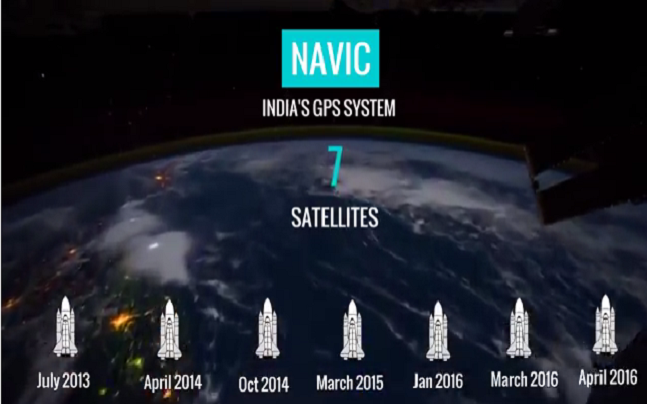IASbaba's Daily Current Affairs Analysis, IASbaba's Daily Current Affairs Aug 2016, International, Science and Technology, UPSC
Archives
IASbaba’s Daily Current Affairs – 17th August, 2016
SCIENCE & TECHNOLOGY
TOPIC: General Studies 3
- Science and Technology- developments and their applications and effects in everyday life
- Achievements of Indians in science & technology; indigenization of technology and developing new technology.
NAVIC: India’s eye in the sky
About NAVIC
- Navigation with Indian Constellation (NAVIC) is India’s indigenous global navigation satellite system.
- NAVIC is expected to become fully operational from this month.
- NAVIC consists of a constellation of three geostationary, four geosynchronous and two on-standby satellites.
- NAVIC will facilitate accurate real-time positioning and timing services over India and the region around it extending to 1,500 km.

Link: http://media2.intoday.in/indiatoday/images/stories//2016May/3_051316042334.png
Key differences between NAVIC Indian Regional Navigation Satellite System (IRNSS) and American Global Positioning System (GPS)
- Radio Frequency
- Accuracy guaranteed
- Modulation
- Area Covered
- Engineering Parameters
- NAVIC Indian Regional Navigation Satellite System or IRNSS significantly more accurate than the American GPS system.
- Unlike GPS, ISRO is recommending a small additional hardware in handheld devices that can receive S-Band signals from IRNSS satellites and inclusion of a code in the phone software to receive L-Band signals.
- Both these L and S-band signals received from seven satellite constellation of the IRNSS are being calculated by special embedded software which reduces the errors caused by atmospheric disturbances significantly. This, in turn, gives a superior quality location accuracy than the American GPS system
- It will consist of seven satellites working in tandem to provide highly accurate coverage over the Indian subcontinent, up to 1,500 km from Indian borders, a region making up the primary service area.

Applications of NAVIC
- Terrestrial, aerial and marine navigation
- Disaster management
- Vehicle tracking and fleet management
- Integration with mobile phones
- Precise timing, mapping and geodetic data capture
- Terrestrial navigation aid for hikers and travelers
- Visual and voice navigation for drivers
Benefits of NAVIC:
- With NAVIC, India joined a club of global powers—the US, EU, China and Russia—who control their own navigation satellite systems. (However NAVIC’s reach is regional)
- NAVIC benefits primarily to Indian citizens (especially the Indian fishermen and navigators, armed forces, emergency services etc.) NAVIC will guide fishermen and sailors by showing the shortest route to regions where there is big concentration of fish. It will also prevent them from straying into foreign waters.
- It will reduce India’s dependence on foreign navigation systems such as US Global Positioning System (GPS)
- Military benefits—it serves Indian security interests in the sense that many of India’s weapon systems, such as guided missiles and bombs, as well as fleet management, rely on satellite navigation.
- NAVIC’s full operationalization carries profound implications and opportunities for the South Asian region at large. Sharing the benefits of NAVIC will improve India’s credentials as a collaborative partner in the region and also reflects India’s commitment to a balanced regional order.
- Having a global navigation system bolsters the ability of a nation to serve as a net security provider.
- GPS has delivered significant strategic and economic benefits to the US. On the similar lines India expects to benefit strategically and economically from NAVIC.
- Through land-area mapping, yield monitoring and precision-planting of crops, NAVIC allows for the development of civic capabilities in food and livelihood security.
- NAVIC also arrives as an instrument for environmental and meteorological monitoring, as well as climate research. These capabilities can be leveraged to design reliable and efficient response mechanisms for natural disasters, alleviating the devastation they wreak through well-managed disaster relief.
- Launch of NAVIC will propel technological innovations. Several present-day civilian and commercial pursuits, from vehicle tracking to mobile phone integration, owe their very existence to satellite navigation technologies. (Much like government-funded space development has served as the backbone of the US’ expansive high-tech industry, NAVIC should also propel technological innovations and spin-offs that render South Asia progressively less reliant on technological imports from the West and elsewhere.)
- NAVIC might even go some way to mend and meliorate relations with a guarded Islamabad. Building on India’s offering of assistance to Pakistan during the floods in Pakistan-occupied Kashmir and other areas in 2014, NAVIC could establish a tradition of regional monitoring whereby India leverages its technological edge to safeguard citizens across the subcontinent. Such gestures could blunt the adversarial nature of Indo-Pakistan relations in the long run, signaling to the region and the globe alike that India values human security despite prevailing gridlock in strategic relations.
India should work to shift the regional frame of mind from defence thinking to subcontinental cooperation and to realize the civilian and commercial promise of NAVIC.
An ability to integrate space infrastructure into the Indian state apparatus has fortunate ripple effects beyond Indian borders. In dedicating itself to exploring and actualizing the civilian and commercial potential of NAVIC, India can signal to its regional partners that its rise is not only passively peaceful but also directly beneficial to those it can lift up in its tide.
Connecting the dots:
- What do you understand by NAVIC? Discuss the advantages India perceives from its ambitious NAVIC programme.
- What are the key differences between NAVIC Indian Regional Navigation Satellite System (IRNSS) and American Global Positioning System (GPS)? Mention the applications of NAVIC.
INTERNATIONAL
TOPIC: General Studies 2
- India and its neighbourhood- relations
- Bilateral, regional and global groupings and agreements involving India and/or affecting India’s interests
- Effect of policies and politics of developed and developing countries on India’s interests
The Beijing balancing act
Recent in news
- Chinese Foreign Minister Wang Yi was on India visit in August 2016
- Two forthcoming multilateral summits
- G20 summit- China- September’16
- BRICS summit- India- November’16
- Both the countries have to downplay the differences as neither country wants the summit to be overshadowed because of it.
- It is necessary to create a positive ambience for the summits in whose success each has a stake as host country
Putting a mechanism in place
NSG
- A focused dialogue will take place betweenà Indian Joint Secretary dealing with disarmament and international security & China’s Director-General of Arms Control and Disarmament
Bilateral relations
- A mechanism has been established between Indian Foreign Secretary and Chinese Vice Foreign Minister
- It is in addition to the existing annual Strategic Dialogue at the Foreign Secretary level and the regular Special Representatives dialogue
- These dialogues have gone beyond the mandate of border negotiations
Other issues such as:-
- China’s “technical hold” on the listing of Masood Azhar, the Jaish-e-Mohammad leader, as a terrorist at the United Nations
- Chinese activities in Pakistan-occupied Kashmir (PoK) under its One Belt, One Road (OBOR) initiative
will form a part of bilateral talks agenda
What to expect?
- China is not likely to materially change its stand on the above mentioned outstanding issues
- But, the proposed dialogue is expected to create a more favourable ambience for the forthcoming summits.
- As the dialogue mechanisms are engaged with these contentious issues, the leaders do not have to deal with them beyond the generalities.
- In Chinese style of working, the summit meetings are expected to be pleasant exchanges with summit leaders. It is to portray the picture that the relationship is positive.
- Last year at Ufa and Tashkent meetings, it had been learnt that the Chinese President was unprepared and uncomfortable with the blunt talks by PM of India in persistently airing the differences between the two countries.
- Hence, it will be Chinese efforts through its foreign minister that such uncomfortable situations are not created in forthcoming summits
Challenging times of China
- It is facing complex and deteriorating political and security situation in its Asia-Pacific periphery
- A major setback was suffered when a tribunal constituted under the provisions of the UN Convention on the Law of the Sea (UNCLOS), in a categorical manner awarded a negative arbitration judgement against China over its claim to the South China Sea
- Relations with ASEAN are under severe strain which is unprecedented.
- There is a worsening of relation with South Korea, with which it has shared over the years a close political, economic, commercial and even cultural relations, because of the deployment of the THAAD anti-missile defence system by the U.S. in South Korea
- The US and Japan are continuously perceived as security threat to China in the region.
Why good relations with India needed?
- Against this background, China would like to have its western periphery side, especially with India, stable and benign.
- The Chinese official media has persistently given out a message that there does not exist any fundamental clash of interests between India and China and the convergences outnumber the differences.
- There also exists an anxiety that India might move close to US and participate in security arrangements more directly challenging China in the South China Sea
- Wrt to South China Sea, China has cautioned India to avoid getting “entangled” in the South China Sea issue.
- But it knows that India’s measured response on tribunal’s verdict, calling for utmost respect for the UNCLOS and also stressing the need for resolving differences through peaceful dialogue will continuously push china to adhere to the stated policy of strategic autonomy
- China expects that forthcoming G-20 summit at Hangzhou will see US and Russia raising the South China Sea issue. In this regard, India’s role could be significant and has a tactical advantage over China
- Due to such reasons and situations, the foreign minister was seen forthcoming on issues India is concerned about.
- However, Chinese substantive stand on these issues is not expected to change anytime soon
India’s reality check
- While dealing with China, India has to keep in mind that asymmetry between both countries in terms of economic and military capabilities is on the rise.
- China’s economy is five times as large as India’s.
- Now with slower growth rates, China will take drastic measures to keep the economy afloat
- India will have to grow much faster over a longer period of time to begin to narrow the gap.
Dealing with asymmetry
- India is not quite in a position to develop the asymmetrical capabilities.
- It is vulnerable to if there is a coordinated move by China and Pakistan.
- Post 1962, the wars between India and Pakistan saw China supporting Pakistan politically and with supplies. But it refrained from attacking India across the border
- Though not encouraging but China’s reassuring pattern of behaviour needs to be under India’s review and assessment of its interaction with China
- However, India has to notice and understand the increased role of Pakistan in Chinese regional and global calculations
- China has shown willingness in standing alone in blocking India’s membership of the NSG on behalf of Pakistan
- It is shielding Pakistan from international pressures consequent upon its use of cross-border terrorism as an instrument of state policy against India
- Pakistan is a low-cost and effective proxy against India for China
- With OBOR, it is assuming long term relation with Pakistan. It has even encouraged Pakistan Army to take charge of implementing the China-Pakistan Economic Corridor (CPEC) since the civilian government of Nawaz Sharif is said to be too slow on delivery.
- Thus, Pakistan is slowly assuming importance in China’s central Asian strategy
Two ways to manage the asymmetry
- To acquire and deploy capabilities which will make any aggressive military move by China a risky proposition
- To get involved more tightly in the U.S.-led countervailing coalition targeting China
However, India should maintain its position as an independent power inspite of involving it in global issues.
Conclusion
- The PM has explicitly committed to the return of PoK including Gilgit and Baltistan to India
- If there is no Pakistan control on this territory, there wouldn’t be CPEC
- If India also encourages anti-Pakistan militants in Balochistan, it would adversely affect the utility of Gwadar port which has a critical role in OBOR initiative
- The Chinese reaction is yet not known but it will be under pressure to moderate heightened anxieties in Pakistan
- However, such actions can have a negative fallout on India-China relations.
- For many years, leaders of both countries have seen it in their mutual interest to keep relations on an even platform despite their essentially adversarial nature
- There has been a competitive and cooperative balance maintained in the relationship.
- The present situations have made setting for managing India-China relations has become more complex and risky and harder to deliver
Connecting the dots:
- India China relations are always on the edge. Examine various issues entangling both the countries.
Related Articles:
All India Radio – India China Strategic Dialogue
All India Radio – NSG meeting and China’s Role
The disconnect between India & USA—‘Middle East’- Read the China factor
Building new alliances with BRICS
The Big Picture – How important is it for India to be part of NSG?
Big Picture- PM Modi’s China Visit-What are the takeaways?
MUST READ
An avoidable war of attrition
Impoverished Balochistan bleeds through a thousand cuts
Related Articles:
In policy shift, Narendra Modi brings up Balochistan again
Answering Pakistan’s provocations
Behind PM Modi’s Balochistan remarks
Rajan: BBB should appoint top executives at state-owned banks
Move to bring all airports under CISF cover
What The Nation Says
World Culture Festival: Sri Sri event destroyed Yamuna’s floodplain
India needs a coalition
India ranked world’s top exporter of information, communication technology
True costs of air pollution
Wind energy sector feels the heat as solar steals limelight
Post-reform India produced too many (unemployable) engineers, too few doctors
NHAI and road ministry’s green fund rejected by finance ministry
What drives caste-based voting?
How India banked on reforms
Unfinished business








